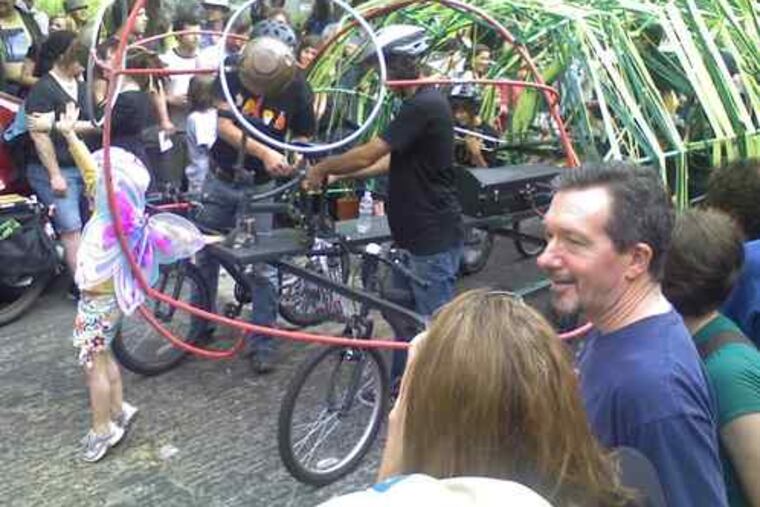Kensington derby gets creative juices flowing
INQUIRER STAFF WRITER It wasn't exactly the Easter Parade. Instead of bonnets, there were helmets. Instead of bunnies and baby chicks, there were a dragon, a giant caterpillar, and a deer head - that last item on a parade entry with a postapocalyptic techno taxidermy theme. Or, in the words of one of its creators, local adman Tom Carr, "Mad Max meets circus carnival."

INQUIRER STAFF WRITER
It wasn't exactly the Easter Parade.
Instead of bonnets, there were helmets. Instead of bunnies and baby chicks, there were a dragon, a giant caterpillar, and a deer head - that last item on a parade entry with a postapocalyptic techno taxidermy theme. Or, in the words of one of its creators, local adman Tom Carr, "Mad Max meets circus carnival."
But then, Kensington's Kinetic Sculpture Derby was never meant to be a sunny stroll down a grand avenue. It has always been a gritty ride past abandoned buildings and funky galleries, led by the artists, engineers, and other creative types who are slowly resurrecting this historic river ward.
The derby ends in a mud pit.
Participants choose a theme for their entry, which must be human-powered. Mostly, that means riding bicycles, but some entrants concocted contraptions they pumped with their arms. Using feet to power a vehicle, a la Fred Flintstone, was strictly forbidden.
On Saturday, crowds swarmed down Frankford Avenue to check out the moving sculptures as they rolled over Kensington's cobblestone and asphalt streets and sloshed through the mud pit that is the derby's grand finale.
Wearing gossamer butterfly wings painted purple, blue, and pink, 6-year-old Leandra Brinkmann was the central character in her family's derby entry, which was based on Eric Carle's children's classic The Very Hungry Caterpillar.
The Brinkmanns and their friends Landis Hennesey, 12, and the Pignetti family constructed the caterpillar from cloth and plastic piping mounted over bicycles. As they approached the mud pit, 12-year-old triplets Donato, Max, and Gianni Pignetti broke out trumpets and a trombone and serenaded Leandra with the theme from Rocky.
Steffen Brinkmann, father of Leandra and Jasper, 12, had foraged in a junkyard for the old shoes, pots, and pans that they incorporated into their caterpillar.
Recycling is a strong ethic of the derby. The Brinkmann crew aimed to spend less than $99, and it did.
"The biggest work was getting the kids together, getting them focused, getting them so that the paint was not smushed all over the sidewalks," said Steffen Brinkmann, an architect who lives in Old City.
Many entries promoted a cause or paid tribute. A papier-mache tree decorated with colorful leaves by a team from the Greater Philadelphia Cultural Alliance honored both the arts and Peggy Amsterdam, the former president of the alliance, who died in December.
Richard Hwang and Amy Krivda, both of South Philadelphia, dressed as vultures. They said they represented forces such as insurance and pharmaceutical companies that they believed had killed "true health-care reform."
Their bicycles pulled a coffin, complete with a likeness of a body with a toe tag that said, "D.O.A."
An entry dotted with tiny plastic bicycles and replicas of iconic Philadelphia buildings such as the Comcast Center touted the East Coast Greenway, a bicycle path its backers hope will run from Florida to Maine.
Reggie Jackson, 12, Bashir Martinez, 9, and Dwayne Harewood, 10, donned chain mail made of corrugated cardboard painted silver to look like knights. They pedaled a vehicle that looked like a giant dragon. They are friends at their West Philadelphia school who also participate in Neighborhood Bike Works, a program that teaches children how to fix bicycles.
"God, I love this," Bashir said, almost growling with delight as he waited for the derby to start. "We got to spray-paint."
Tom Carr, John Spetrino, and their friends scavenged in junkyards and on Craigslist for parts for their entry, which included four vehicles. They bought irrigation pipe, added spokes, and riveted treads from old mountain bikes onto them to make wheels about three feet tall.
To one vehicle they added a steering wheel like the one a captain would use on a ship. Bowling pins served as handles. They also incorporated dead animals - a deer's head attached to a seat, bones adorning a hat. A thumping techno beat heralded the group's arrival.
Carr and his friends built their entry in an empty space in Fishtown where the sign outside read "Frank R. Rosen Kitchens." Its logo was a T-square.
Wearing a cowboy hat and drinking a beer, his arms covered in tattoos, Carr explained that they didn't know who Rosen was.
"He's just a metaphor now," he said.
Just then, Ken Richman walked over. He had seen the Rosen sign that Carr and his friends had duplicated near their fleet of carriages.
Frank R. Rosen was Richman's great-uncle. Richman's father, Bernard, had run the company.
Richman had come to the derby after reading about it in the paper and introduced himself when he saw the T-square.
"I grew up with that logo," he said.
Their metaphor now a reality, Carr and his crew were thrilled.
"This is a big treat for us," he said.